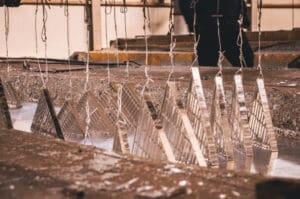You’re standing at the design table. Before you are the plans for a copper component destined for the heart of an electrical switchgear.
It needs to operate flawlessly for years. It must conduct electricity perfectly, yet also be corrosion-resistant. What technology should you choose to protect it? This isn’t a question of which looks “nicer.” It’s a decision that will impact the safety and functionality of the entire system. In electroplating, there is no single right solution – only the one best suited for the job.
When you need more than just protection, electroplating steps in
There are times when a simple protective layer just isn’t enough. You need to precisely give the surface entirely new properties. This is a job for Electroplating. We’re talking about a process where, with surgical precision, micrometer by micrometer, we apply a layer of another metal – like silver, tin, or nickel – onto a part (e.g., made of copper or aluminum). We do this in a plating bath, controlling the electric current to achieve the exact effect required by the design.
Think of it like tuning. A silver coating doesn’t just protect; it maximizes electrical conductivity. A tin coating ensures the component can be soldered without issues, and nickel creates a rock-hard barrier against abrasion. Can you achieve such precision with another method? I sincerely doubt it. That’s why in electronics and the energy sector, where every detail matters, this method reigns supreme.
When reliability in harsh conditions is key – galvanization in action
Now let’s change the scenario. Your component will be working outdoors, exposed to moisture and temperature changes. The priority becomes heavy-duty protection and the repeatable production of thousands of identical parts. This is where a specialized process, which we refer to as galvanization in a technical context, comes into play. This isn’t about dipping steel in a vat of molten zinc, but about advanced, automated plating lines that create dense and durable protective coatings on copper or aluminum.
The goal is to create a barrier that just works. Reliably. For years. Thanks to full automation, we can be sure that every part coming off the line has an identical, perfectly adhered protective layer. This is crucial in the automotive industry and in the construction of renewable energy infrastructure, where there’s no room for experiments and only proven, solid technology counts.
How to make the decision? Your engineering cheat sheet
Choosing the right technology is the heart of the matter. Before you make a decision, ask yourself a few questions. This is my internal checklist:
What is the main goal? Do you just want to protect the metal, or do you need to give it new functions (e.g., better conductivity, solderability)?
Where will the part be used? In sterile conditions inside a device, or outdoors, battling rain and frost?
How important is dimensional precision? Could applying a thicker layer affect the component’s assembly?
What is the production scale? Do you need a few prototypes or thousands of identical parts with guaranteed quality?
Do you anticipate further processing? Will the part be powder-coated later? Some coatings work better with paints than others.
Conclusion: The right choice is fundamental
At the end of the day, there’s no such thing as “better” or “worse” technology. There is only well-chosen or poorly-chosen technology. Both Electroplating and specialized galvanization are powerful tools in an engineer’s hands. The art is knowing which one to use at the right moment. It is this understanding of the differences that makes components work efficiently, safely, and for many years to come.
Read more:
Not all coatings are created equal. How engineers choose between precision and durability















